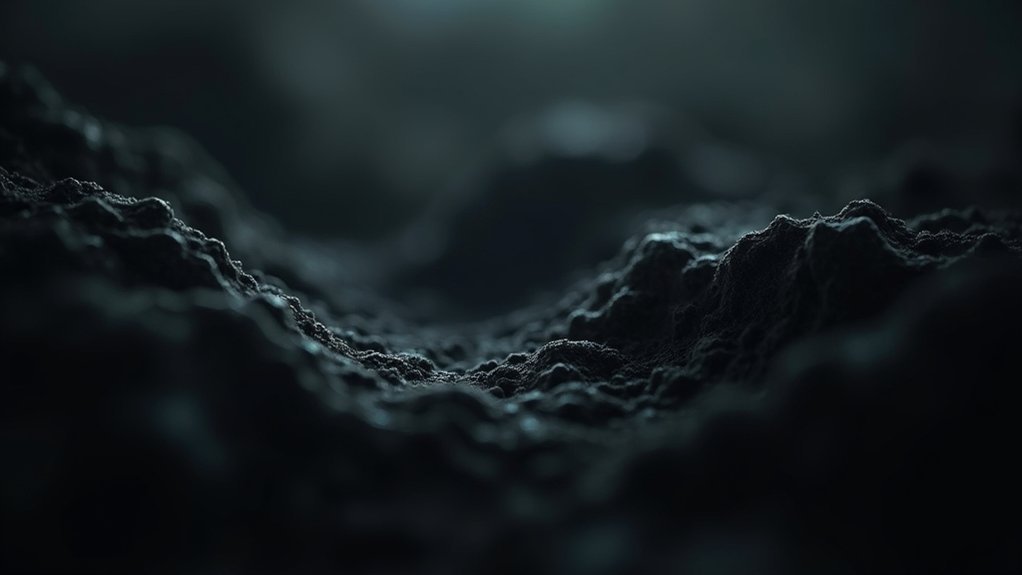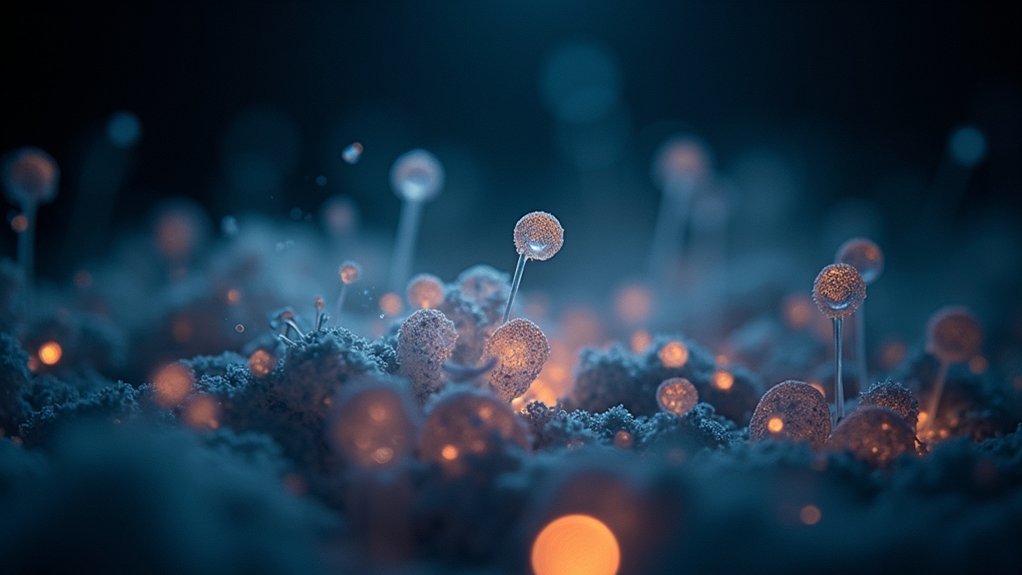Dark field images appear blurry and dim because only scattered light from your specimen reaches the objective lens, while direct illumination is blocked. This limited light entry reduces overall brightness, and the complex scattering pathways can soften details. Your aperture settings further restrict light transmission while attempting to maintain the dark background. Proper alignment and optimized camera settings can greatly improve image clarity. The techniques below will help you transform those hazy specimens into crisp, detailed observations.
Numeric List of Second-Level Headings

Four key factors contribute to the blurriness and dimness in dark field images. Understanding these core issues will help you improve your microscopy results:
- Limited Light Entry
- Aperture Size and Depth of Field
- Scattered Light Intensity
- Focusing Precision
When you’re working with dark field microscopy, you’ll notice these factors interact with each other. For example, a smaller aperture increases your depth of field but simultaneously reduces light transmission, creating dimmer images.
Meanwhile, the scattered light that illuminates your specimen needs sufficient intensity to reveal fine details. Without proper focus adjustment, even well-lit specimens appear blurry.
Additionally, the inherently low contrast in dark field microscopy makes distinguishing minute structures difficult, contributing to the perceived lack of sharpness in your images.
The Physics Behind Dark Field Illumination
Understanding the physics of dark field illumination reveals why your images often appear blurry and dim. When you use this technique, light strikes your specimen at oblique angles rather than passing directly through it. Only scattered light from your sample reaches the objective lens, creating that distinctive bright-against-dark contrast.
| Light Behavior | Effect on Image |
|---|---|
| Oblique illumination | Creates dark background |
| Scattered light only | Reduces overall brightness |
| Edge diffraction | Produces halo effects |
| Refractive index differences | Enhances contrast |
| Light path complexity | Requires precise alignment |
This scattering process inherently reduces light intensity, making images appear dimmer. Additionally, the light that diffracts around the edges of your specimen creates those characteristic halos that contribute to perceived blurriness. Proper alignment becomes essential—even slight misalignments amplify these effects, further degrading image clarity.
Light Scattering Effects on Image Quality

While light scattering creates the characteristic contrast in dark field microscopy, it’s also the primary culprit behind your blurry and dim images. When light scatters from your specimen, it follows multiple pathways before reaching your detector, resulting in significant light loss and reduced intensity.
This scattering effect doesn’t just dim your image—it compromises focus quality. As scattered photons travel varied paths, they create a diffusion effect that softens details. You’ll notice this especially as scattering increases, where your effective depth of field shrinks, making areas outside the focal plane appear more blurred.
To combat these effects, you’ll need precise alignment of your light source. Proper adjustment minimizes unwanted scattering while preserving the contrast that makes dark field imaging valuable for visualizing transparent specimens.
Aperture Limitations in Dark Field Microscopy
While light scattering creates the characteristic contrast in dark field microscopy, it’s also the primary culprit behind your blurry and dim images. The technique’s smaller aperture further compounds these issues by restricting light entry into your optical system.
When you’re working with dark field microscopy, you’re facing a delicate balance. The smaller aperture that blocks direct light is essential for the dark background effect, but it simultaneously limits the overall brightness of your specimen.
Additionally, if your microscope’s numerical aperture isn’t optimized, you’ll struggle to capture scattered light effectively, resulting in blurred images.
Precise alignment becomes even more critical with these aperture constraints. Any minor misalignment can dramatically reduce image clarity, especially when the high contrast between your bright specimen and dark background already makes accurate focusing challenging.
Contrast Challenges in Low-Light Conditions

The dim environment of dark field microscopy creates a perfect storm for contrast challenges. When light levels drop, the distinction between your specimen and its background markedly diminishes. Your camera struggles to identify where one object ends and another begins, resulting in that characteristic blurry appearance.
In these low-light conditions, your camera’s aperture widens to capture more light, but this adjustment comes at a cost. The increased depth of field reduces overall image sharpness due to diffraction effects.
Your eyes compound this problem, as human vision naturally loses the ability to perceive fine details in dimly lit settings.
Even high-contrast techniques typically employed in dark field imaging often fail in these scenarios, leaving you with images that lack the clarity and definition you’re seeking.
Technical Solutions for Sharper Dark Field Images
You’ll find considerably sharper dark field images by increasing your aperture size to allow more light to reach the sensor while carefully optimizing your focal point.
Enhancing your light sources through higher ISO settings or longer exposure times (with a tripod for stability) can dramatically improve image brightness without sacrificing clarity.
Consider implementing focus stacking techniques to overcome the limited depth of field inherent in dark field photography, which combines multiple images taken at slightly different focus points into one crisp composite.
Optimizing Aperture Settings
How effectively can you combat the inherent blurriness of dark field imaging through simple aperture adjustments? The secret lies in selecting a smaller aperture (higher f-stop number) to increase your depth of field.
This adjustment gives you greater control over the light cone entering your camera, enhancing clarity even in challenging low-light conditions.
When you decrease your aperture size, you’ll need to compensate for reduced light by extending exposure time. Be cautious—longer exposures can introduce motion blur if your camera isn’t properly stabilized.
Finding the ideal balance between sharpness and adequate exposure becomes critical.
Don’t overlook lens maintenance—regular calibration and keeping your lens free from imperfections prevents light convergence issues.
Experiment with different aperture settings to discover the best configuration for your specific dark field imaging needs.
Enhancing Light Sources
While dark field imaging inherently relies on scattered light, upgrading your illumination sources can substantially transform image quality.
Consider replacing standard bulbs with higher-intensity LED or fiber optic illuminators to boost overall brightness and contrast in your dark field images.
You’ll achieve the best results by optimizing the positioning and angle of your light source.
This strategic adjustment enhances how light scatters off your specimen, producing sharper, more defined images.
Don’t overlook the power of optical filters, which effectively reduce background noise and improve specimen visibility.
For maximum clarity, pair your enhanced light source with a narrower aperture setting.
This combination increases depth of field, giving you a wider range of focus and notably reducing the blurriness that typically plagues dark field microscopy.
Focus Stacking Techniques
Focus stacking represents one of the most effective solutions for combating the inherent blurriness in dark field microscopy. This technique involves capturing multiple images at different focal points and then merging them into a single, sharper composite.
When you’re working with dark field samples, the typically shallow depth of field severely limits what appears in focus. By taking sequential images across various focal planes, you’ll guarantee both foreground and background elements remain crisp.
You’ll need specialized software to align and blend these images, effectively reducing blur while enhancing clarity.
For best results, maintain consistent lighting and camera settings throughout your image sequence. This prevents unwanted variations in exposure and color balance.
Focus stacking is particularly valuable for detailed macro work, where you’d otherwise struggle to achieve adequate depth of field with a single exposure.
Frequently Asked Questions
What Are the Problems Associated With Dark Field Microscopy?
You’ll encounter problems with dark field microscopy including blurry and dim images due to insufficient light scattering, low numerical aperture, improper light alignment, and poor sample preparation with thick specimens.
What Is the Resolution of the Dark Field Microscope?
Dark field microscopes typically achieve resolutions around 200 nanometers. Your results depend on your objective’s numerical aperture – higher NA values will give you better resolution. Using shorter wavelengths can also improve your image quality.
What Does Dark Field Microscopy Test For?
Dark field microscopy tests for transparent specimens you can’t easily see with standard methods. It helps you detect bacteria, observe cell morphology, and monitor living organisms’ movements without stains, revealing structures through light scattering effects.
How Are Images Focused Under a Dark Field Microscope Visualized?
You’ll visualize dark field images by seeing bright objects against a dark background. When you focus correctly, scattered light from your specimen enters the objective lens, creating sharp contrast that reveals transparent structures clearly.
In Summary
You’ll find that dark field microscopy inherently trades brightness for contrast. By mastering proper specimen preparation, optimizing your aperture settings, and investing in high-quality equipment, you can minimize blurriness and dimness. Remember to regularly maintain your microscope and experiment with exposure settings. With practice and these technical adjustments, you’ll capture clearer, more detailed dark field images that reveal the subtle structures conventional microscopy might miss.





Leave a Reply